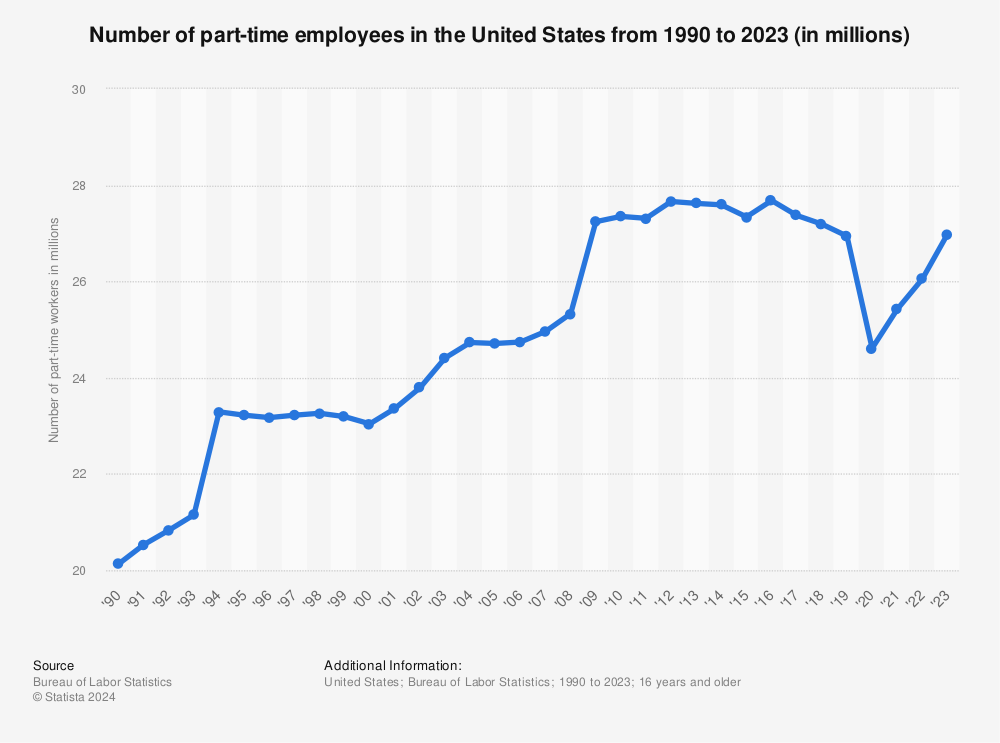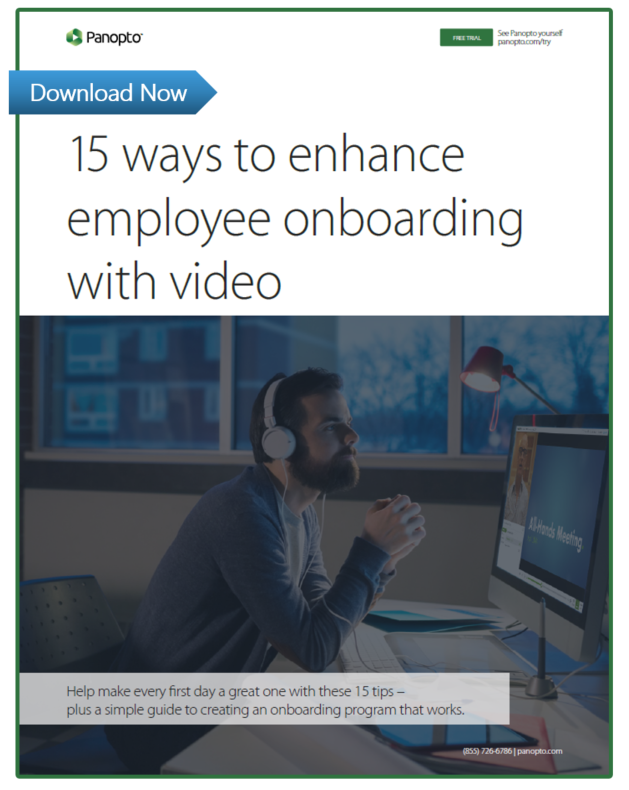- Onboarding
Onboarding Hourly Employees Is Different

Taking on a new position in retail, hospitality, or any service industry is no easy task. There are skills to learn, policies to memorize, and point-of-sale (POS) systems to master. Onboarding can be challenging in even the best of circumstances.
Part-time and hourly employees are essential to operations across many industries. What’s more, retail staff, cashiers, servers, baristas, front-desk associates, service technicians, and delivery teams are the face of the brand — they’re the ones who interact with customers every day.
As customers expect ever greater levels of convenience and service, these positions are becoming ever more important. According to recent data, the number of part-time positions in the U.S. has grown 18% since 2000, with the largest jump happening following the Great Recession in 2008.

Find more statistics at Statista
Why Do So Many Organizations Skimp on Onboarding Hourly and Seasonal Employees?
Many companies have expanded employee onboarding programs for full-time professionals and corporate employees, while hourly and seasonal employee training practices still only include the bare minimum. This is typically justified by a common set of concerns:
- The scale required to train part-time employees is too large. The ratio of corporate trainers to potential trainees, if hourly employees were included, would be thousands — perhaps millions — to one.
- The geographic distance is too large. For large organizations relying on in-person onboarding, accounting for travel logistics may be too much to handle. Even without considering retail stores, the effort required of a training team to onboard every employee in person at for a business with just a half dozen offices would be staggering.
- Turnover is too great to justify the expense. A great many hourly positions are designed to be seasonal or temporary, and even of those that aren’t (particularly in the retail and hospitality sectors), turnover rates are high. It simply isn’t cost effective to deliver comprehensive onboarding to associates likely to leave in a few months.
Providing an Exceptional Onboarding Experience for Hourly Employees Matters
For many organizations, the onboarding process attempts to solve a difficult problem: how to provide time-sensitive training, tailored to specific roles, and delivered to small audiences that may be remotely located across the country or around the world?
It’s a daunting task, but an important one — with real implications to your bottom line.
- Getting new employees up to speed on the culture, processes, and knowledge base of a company can cost up to 30 percent of a new hire’s annual salary.
- Poor communication and ineffective training are cited by 1 in 4 employees who’ve quit a job within six months of starting
- Filling a job left vacant due to poor onboarding on average costs companies nearly $11,000.
Those stats don’t just apply to senior executives — they hold true for every position in your organization, right down to the junior sales associates, associate sales techs, and third-shift customer support representatives. High turnover rates add up quickly, too. It’s estimated that a quarter of companies spend nearly 40 percent of their yearly earnings on turnover-related expenses.
In fact, the potential impact of skimping on onboarding for hourly employees might be even greater than the raw numbers suggest. An internal data analyst at corporate HQ, for example, can take months to get to know the company culture and processes without causing much consternation. But customers expect the employees they engage with to be perfectly knowledgeable and capable representatives — right from their very first minutes on the clock.
There is good news, though. Data also shows that a structured, consistent onboarding process can decrease hourly employee turnover while improving performance.
How To Make Onboarding For Hourly Employees Easy, Affordable, And Scalable
Just as with any organizational learning and development activity, onboarding hourly employees first requires employee training teams to find the right balance of information to teach and time available for teaching. In the past, onboarding for hourly and seasonal employees was delivered by local and regional managers with other responsibilities to manage simultaneously, who often put their own spin on the “onboarding process.” But there’s a better way to onboard hourly and seasonal employees.
A new type of employee onboarding software has brought scale, accessibility, and consistency to new employee training.
 With a video onboarding solution, organizations can develop reusable training content that can be accessed from any location, provide specialized training to thousands simultaneously, and effectively acclimate each and every new hire to the company culture — even those in temporary or high-turnover roles.
With a video onboarding solution, organizations can develop reusable training content that can be accessed from any location, provide specialized training to thousands simultaneously, and effectively acclimate each and every new hire to the company culture — even those in temporary or high-turnover roles.
Business 2 Community writer Breanna Vander Helm recommends businesses make automation a cornerstone of any part-time employee training. Automation, she notes, is essential to helping hourly employees balance professional development and on-the-clock responsibilities. Technology can also play a role in another of her recommendations, designing an ongoing onboarding process that can include 30, 60, and 90-day goals to keep employees engaged and motivated.
Related Reading: Investing In Training For Frontline Employees In The New Service Economy
When companies invest in new hire training and follow onboarding best practices, they reap the benefits of reduced turnover and improved productivity. In forward-looking companies, video has already become an essential part of that investment, helping to scale and expand onboarding activities. Here’s why:
- Video helps employees retain knowledge. Studies show that just 7 days after they finish a training session, your people will remember only 35% of the material you’ve covered. Pairing video presentations with the traditional handbook, however, was 83% more effective at helping employees remember the information covered.
- Video helps reduce training program costs. After finding that up to 40% of its classroom training costs were spent on travel and lodging, IBM moved half of its training programs to an e-learning format. Over the first two years of the program alone, the company has saved $579 million.
- Video helps companies ensure training material consistency. For larger organizations, or those with geographically dispersed offices, storefronts, or sales territories, consistency is a big challenge to proper onboarding. Having multiple trainers — or wholly separate teams or departments — in charge of onboarding increases the likelihood that your new employee experience will be different for every new hire. Leveraging video training during onboarding solves that problem, ensuring that each employee will still have a similar experience and will receive a consistent message regardless of who conducts the training.
- Video helps employees feel more engaged and connected from day one. Onboarding isn’t just training — it’s a delicate process of introducing a new employee to the culture and values of a company. Onboarding helps your new hires become effective members of your organization. The potential value of effective onboarding has been well-documented — already researchers have found that well-executed onboarding techniques lead to positive outcomes such as higher job satisfaction, better job performance, and greater organizational commitment.
Panopto: It’s more than an employee onboarding solution.
Panopto provides a flexible solution for efficient virtual communication and training that brings the benefits of working in the head office to your remote teams. From company policies to team-specific processes and procedures, Panopto makes it easy for managers, trainers, subject matter experts, and even new hires themselves to record, share, and search for on-demand videos.
With Panopto, you can maximize learning and development across your entire workforce while improving the flow of information at scale so your business can be more innovative, agile, and profitable than ever before.
Try Panopto for free and see how easy it is to start creating a custom, on-demand training video library that supports your hourly associates, regional managers, and corporate employees.



